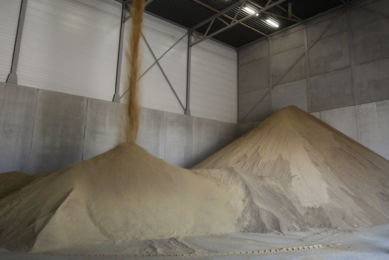Vitamins – vital nutrients for health and production

Without vitamins pigs cannot grow as the industry wants them to do. In this series of three articles, general knowledge on vitamins is refreshed – what vitamins exist, which ones are indispensible for pigs and how to formulate diets with vitamins?
By Gilberto Litta, global category manager vitamins, DSM
Vitamin nutrition is understood very well and has been the subject of comprehensive research over many years. This has yielded valuable tools to ensure that domestic animals in human care are given the best opportunity to realise their genetic potential in terms of health, growth and feed efficiency. Not only do vitamins contribute significantly to production economy and animal welfare but they also play a major role in reducing the carbon footprint from animal farming and food production.
Vitamins are normally added to the overall feed programme via the premix component of the diet and typically this might be 25kg inclusion into a tonne of finished compound feed. Where the calculated inclusion of a specific vitamin might be 5-50g per tonne of finished feed, the precision of the mix dispersion and general feed manufacture must be carefully managed by the vitamin and premix manufacturer, the compound feed manufacturer and the home mixing farmer.
Vitamins – or as they were known at one time ‘vital amines’ – have a range of activities in animal feed programmes from the low end where deficiency symptoms are evident (and these are well documented) all the way through to the middle range where there are curvilinear relationships with animal performance. Then there is the top end to very high levels of input, where effect is focused on special applications like boosting immune response or meat quality traits.
In formulating complete feed programmes, this middle band is where the industry operates. Figure 1 (see attached pdf) gives a schematic illustration of the levels of general vitamin inputs towards the expectation of post-weaning piglet growth. Extremities of input should be avoided but it is also an economic necessity to strike the correct optimum position for maximum profitability.
Vitamins – definitions & functions
Firstly some basic notions on vitamin functions. Vitamins are active substances essential for the life and well-being of the animal and this applies to piglets, growing/finishing pigs, sows and also boars. Vitamins are characterised by two basic properties:
1. Daily requirements for each vitamin are very small – usually measured in mg or μg.
2. Vitamins are organic compounds and hence differ in this respect from trace mineral nutrients.
Vitamins express catalytic functions: they can facilitate both synthesis and degradation of other nutrients – and therefore play a major role in the control of general metabolism. They are always required for optimum health and normal physiological functions such as growth, body development and reproduction. Most vitamins cannot be synthesised by the animals and they must be obtained from the feed.
In Table 1 (see attached pdf) a general description of the major vitamins that are required in animal nutrition is given plus a basic function for each. It can be seen that many of these compounds impact on general growth, feed efficiency and health status – in other words they have a profound influence on the overall performance and profitability of the animal.
Deficiency symptoms in pigs
Vitamin deficiency symptoms are still seen on pig farms on a regular basis. Symptoms could be severe necrosis due to biotin deficiency, navel bleeding due to a vitamin C deficient sow and splayed hind legs due to pantothenic acid deficiency.
The reasons why vitamin deficiencies arise are many and varied but not least due to an inadequate feed intake (for management reasons) which is inextricably linked to inadequate vitamin intake. The presence of vitamin antagonists is also a cause. Mixing errors and poor formulation are a major problem. Poor digestion and hence absorption due to chronic or acute diseases are also major causes.
Vitamin requirements
Specific vitamin requirements vary widely and are influenced by the fact that many vitamins have positive or negative interactions amongst them. Vitamins can therefore never be considered in isolation but better as a whole programme. Fat soluble vitamins, for example, must be fed in correct ratios as they all compete for intestinal absorption. Water soluble vitamins are also regulators of the intermediary metabolism of protein, fats and carbohydrates (energy) and a lack of any one can increase the need for the others.
Figure 2 (see attached pdf) presents a schematic to show the complexity of vitamin interactions and the consequence of this is the difficulty in arriving at specific requirements for individual vitamins in the feed. It can be seen from this representation that almost all of the vitamins listed in Table 1 have an interactive function in both energy metabolism via Krebs Cycle and also in protein deposition and lean tissue growth via the control of the amino acid pool.
Impact
Vitamin applications are used at relatively small inclusions into finished feeds but the impact of this component on the finished feed has major consequences for growth, feed efficiency and reproductive processes. Some vitamins also have significant effects on carcass the quality. The actual values applied in commercial nutrition are also very much a ‘movable feast’ in that genetic improvement constantly changes the game and further research gives new insights. DSM estimate that due to constant genetic change in growing pigs there is likely to be a 1% change every year in overall vitamin requirements.
With constant selection and improvement of feed conversion ratios, feed intake itself tends to be reduced over time. Thus, there is a need to revise the actual in-feed concentrations of vitamins to maintain the daily consumption per animal. In addition, there is also an effect of modern animal production methodology at optimum stocking densities and in large populations under intensive conditions. This can induce chronic stress reactions in livestock, subsequently affecting vitamin requirements and in-feed concentrations.
The take home message for producers and farm managers is that they should be aware of these issues and relationships and understand the effects on their own animals and farm units. DSM Nutritional Products have developed the Optimum Vitamin Nutrition concept, aimed at providing commercial nutritionists and nutritional advisers to home mixers with effective tools and guidelines for high precision formulation. The next two articles in this series will discuss specific vitamin values for pigs as well as the formulation of working diets.
The author can be reached at gilberto.litta@dsm.com.











